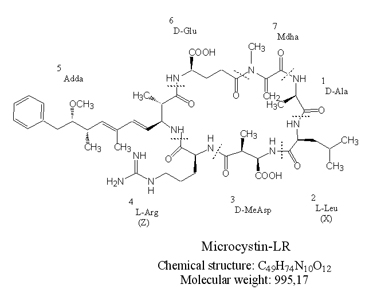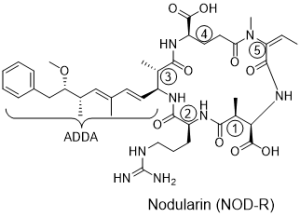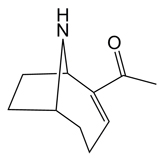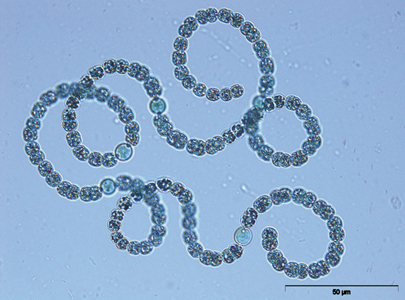The cyanobacterial toxins are a diverse group of natural toxins, both chemically and toxicologically. Cyanobacteria (also known as blue-green algae) produce a variety of unusual metabolites with unclear function, whereas some of this are toxic to humans and animals. During blooms of cyanobacteria, the cyanotoxins may accumulate in fish, crayfish or shellfish, causing food poisoning episodes.
The natural toxins include hepatotoxins (such as microcystins, nodularins and cylindrospermopsins), neurotoxins (such as anatoxins and saxitoxins) and dermatoxins.
- Microcystins
- Nodularins
- Cylindrospermopsins
- Anatoxins
- Saxitoxins
Microcystins
Microcystins (MCYST) are hepatotoxic cyanobacterial toxins. In early 1959, the first microcystins were isolated from the cyanobacterium Microcystis aeruginosa as so called “death factor”. The isolated compounds were later named microcystin after the source organism Microcystis aeruginosa.

Structure
In the early 1980s the complete structure of the first microcystin variant microcystin-LA was identified. Microcystins are cyclic heptapeptides with the general structure: cyclo-(D-alanine1-X2-D-MeAsp3-Z4-Adda5-D-glutamate6-Mdha7). The amino acids in position 2 and 4 are variable L amino acids, D-MeAsp3 is D-erythro-β-methylasparticacid, and Mdha is N-methyldehydroalanine. The amino acid Adda, is (2S,3S,8S,9S)-3-amino-9-methoxy-2,6,8-trimethyl-10-phenyldeca-4,6-dienoic acid. Structural variations have been found in all seven amino acids. The most frequent variations are substitutions of the L-amino acids at position 2 and 4 and demethylation of amino acids at positions 3 and 7. Today more than 80 different microcystins are known.
Source organisms
Microcystins are produced by cyanobacteria belonging to different genera e.g. Microcystis, Anabaena, Oscillatoria, Planktothrix, and Nostoc. They are most commonly found in cyanobacterial blooms in freshwater worldwide. Marine sources for microcystins are not yet known.


Microcystis aeruginosa
Toxicity
Microcystins are synthesized and are mostly retained in the living cyanobacterial cells. After senescence and cell lysis they are released into the surrounding water. Due to their chemical stability microcystins can persist in the water for several days or weeks after the breakdown of the cyanobacterial bloom. Most Microcystins are water soluble and can not penetrate lipid membranes of humans, animals and plants. However, microcystins have been implicated in poisonings of humans and animals. After oral uptake microcystins are transported, particularly through bile acid-type transporters, from the ileum into the bloodstream and finally are concentrated in the liver as a result of active uptake by hepatocytes. Microcystins are primarily hepatotoxins. Acute exposure to microcystin causes severe liver damage. Characteristic features are a disruption of liver cell structure (due to damage to the cytoskeleton), a loss of sinusoidal structure, increase in liver weight due to intrahepatic haemorrhage, haemodynamic shock, heart failure and death. Other organs affected by microcystins are kidneys, intestines and lungs. Microcystins are liver tumor promoters mediated through inhibition of protein phosphatase type 1 and type 2A activities. One of the most toxic microcystin variants is microcystin-LR which has an LD50=50 µg kg-1 (mouse, intraperitoneal). Orally applied Microcystis extracts were found to have an around 50- to 170-fold higher LD50. The World Health Organization (WHO) has established a guideline of 1 μg/l as a maximum concentration of microcystin-LR in drinking water.
References
Chorus, I. and Bartram, J. (1999) Toxic Cyanobacteria in Water: a Guide to Public Health Significance, Monitoring and Management. E & FN Spon /Chapman & Hall, London, 416 pp.
http://www.who.int/water_sanitation_health/resourcesquality/toxicyanbact/en/
Welker, M. and Döhren, H. (2006): Cyanobacterial peptides – Nature’s own combinatorial biosynthesis. FEMS Microbiol. Rev. 30:530–563.
WHO (2003) Cyanobacterial toxins: Microcystin-LR in drinking-water. Background document for preparation of WHO Guidelines for drinking-water quality. Geneva, World Health Organization (WHO/SDE/WSH/03.04/57).
WHO (2011) Guidelines for drinking-water quality – 4th ed. Geneva, World Health Organization. ISBN 978 92 4 154815 1
https://www.unicef.org/cholera/Chapter_4_prevention/01_WHO_Guidelines_for_drinking_water_quality.pdf


